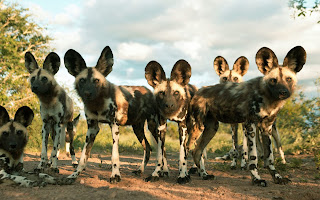
The African wild dog, also known as the Cape Hunting Dog or Painted Dog, belongs to the canine family. These animals live in open plains and forests south of the Sahara. They prefer dry areas and savannahs. African wild dogs are critically endangered. Your number. fell largely because farmers who wanted to protect their livestock slaughtered extensively. In addition, African wild dogs are prone to diseases that affect pets. In addition, habitat loss affects the survival of African wild dogs.
African wild dogs live in packs that are usually dominated by a monogamous breeding pair.
African wild dogs can reach the height of 30 inches at shoulder. They usually weigh between 55 and 70 pounds.
The female has a litter of two to 20 pups, which are cared for by the entire pack.
African wild dogs have long legs, strong jaws and large, bat-like ears. Their body is covered with fur which has irregular patches of red, brown, black, yellow and white color.
These dogs are very social, and packs have been known to share food and to assist weak or ill members.
Social interactions are common, and the dogs communicate by touch, actions, and vocalizations.
African wild dog looks like a domestic dog. Unlike dogs, African wild dogs have four toes instead of five on their feet.
African wild dogs hunt in formidable, cooperative packs of six to 20 (or more) animals.
African wild dogs live and hunt in large packs that usually consist of 6 to 20 members. Strength of the pack depends on its size. Larger packs are more successful in hunt and in raising of the young animals.
Larger packs were more common before the dogs became endangered.
All members of the pack take good care of other animals in the pack, especially of weak, young and old individuals. They never show aggression toward other members.
Packs hunt antelopes and will also tackle much larger prey, such as wildebeests, particularly if their quarry is ill or injured.
Members of the pack communicate using vocalization, touch and visual signs.
The dogs supplement their diet with rodents and birds.
Each pack of African wild dogs has a dominant female and male couple. They guide the pack and perform reproduction.
As human settlements expand, the dogs have sometimes developed a taste for livestock, though significant damage is rare and most dogs prefer wild prey.
African wild dogs hunt co-operatively, usually early in the morning and late in the night. They hunt antelopes, warthogs, wildebeest, rats and birds. African wild dogs are among the most successful hunters in Africa.
African wild dogs are among the many species that benefit from the creation of protected wildlife corridors that help connect their increasingly fragmented habitats.
African wild dog can run 35 miles per hour and travel great distances during the day. When pack has young members, daily routes become shorter.
Though they were once found throughout the continent—from desert to mountain habitats—African wild dogs have disappeared from most of their geographic range.
African wild dogs are territorial animals. Average size of the pack’s territory is 1500 square kilometers.
These days, African wild dogs typically roam the open plains and sparse woodlands of sub-Saharan Africa.
Mating occurs between dominant pair in the pack. Female has one litter per year. Number of pups per litter can range from 2 to 20. Usually, female gives birth to 10 pups. There are twice as many males than females in the litter.
Their largest populations can be found in Botswana, Zimbabwe, Namibia, Zambia, Tanzania, and Mozambique.
All members of the group take care of the babies. After successful hunt, both females and males regurgitate swallowed food to feed the youngest members of the pack.
These long-legged canines have only four toes per foot, unlike other dogs, which have five toes on their forefeet.
Although litters can have nearly 20 babies, survival rate is very small. Babies usually die as a result of floods and diseases. All females that reach maturity will leave the pack. Unlike them, males will stay within their native pack.
The African wild dog is known by many names, including Cape hunting dog or painted dog.
African wild dogs can survive up to 11 years in the wild.
Each animal has its own unique coat pattern, and all have big, rounded ears.








